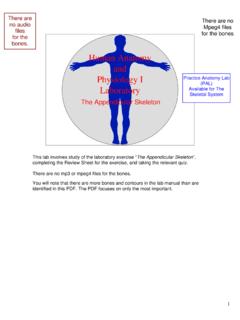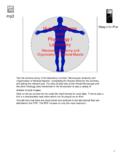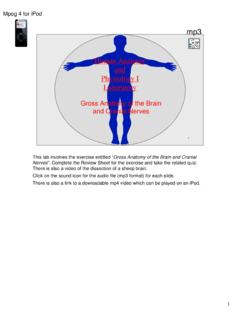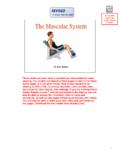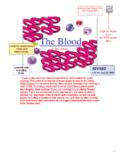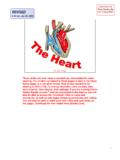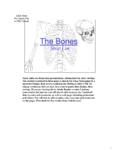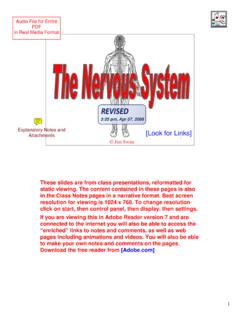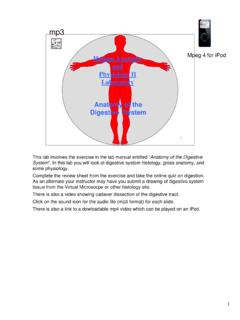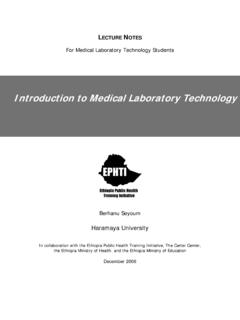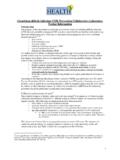Transcription of Human Anatomy and Physiology II Laboratory - …
1 11 Human Anatomy and Physiology IILaboratory The Respiratory SystemThis lab involves two exercises in the lab manual entitled Anatomy of the Respiratory System and "Respiratory System Physiology ".In this lab you will look at lung histology, gross Anatomy , and Physiology . Complete the review sheets from the exercise and take the online quiz on respiration, As an alternate your instructor may have you submit a drawing of lung tissue from the Virtual Microsocpe or other histology site. Use the PhysioEX software to measure an analyze respiratory volumes. There is also a video showing cadaver dissection of the respiratory on the sound icon for the audio file (mp3 format) for each slide. There is also a link to a dowloadable mp4 video which can be played on an TractUpper respiratory division Respiratory tree (Lower respiratory division)Nasal cavityTrachea 1oBronchi Pleurae Diaphragm Ribcage (thoracic wall)Larynx Pharynx The respiratory tract can be thought of as consisting of two parts: the upper respiratory tracthas the nasal cavity, and the pharynx; The lower respiratory tracthas the larynxand the respiratory treefrom the tracheathrough the various divisions of bronchito the bronchioles.
2 Essentially the upper division is where the cilia beat down to move mucus down to the throat to be swallowed, and the lower division is where cilia be up to move mucus to the throat to be Respiratory TractSee the Lab Manual for items you are responsible for inthe Upper Respiratory LarynxTracheaAnterior viewThyroid cartilageHyoid boneCricoid cartilageepiglottisMispronunciation of the larynxis an anatomical pet peeve. It is pronounced lair-inks, and consists of anumber of cartilages along with the ligaments which connect them. The larynx is connected to the hyoid bone by the thryrohyoid ligament. The thryroid cartilageis the largest and its anterior prominence is the Adam s Apple .55 Sagittal Section of the LarynxTracheaPomum Adamii(Adam s Apple)Hyoid boneCricoid cartilageEpiglottis ArytenoidcartilageVocal folds (true vocal cords)Vestibular folds (false vocal cords)Arytenoid musclesThyroid cartilageWhen you swallow the hyoid bone lifts up and this causes the cartilaginous epiglottisto hinge backwards, guarding the opening into the glottis to prevent aspiration.
3 The glottisis the opening between the vocal folds, which are the vocal cords. The vocal folds are guarded by the vestibular folds. The arytenoid cartilage,controlled by arytenoid muscles, swivels to regulate tension on the vocal folds in producing the pitch of the voice. 66 Respiratory Tree(Dissected Specimen)Thyroid glandPrimary bronchiThyroid cartilageCricoidcartilageA dissected cadaver specimen of the larynx with its attachment to the respiratory , anterior viewThyroid cartilageCricothyroid muscleCricoid cartilageThe many small muscles found attached to the larynx have been removed from this specimen, along with the thyroid , posterior viewEpiglottis hyoid boneSuperior horn of thyroid cartilageArytenoidmusclesCricoid cartilageAryepiglotticfold and muscleCricoarytenoid musclePiriform recessMembraneouspart of tracheaThe epiglottis is not a separate leaf-like structure as it is often pictured, but rather is attached to the aryepiglottic fold to form more of a trumpet.
4 Sagittal sectionEpiglottis ArytenoidmuscleCricoidcartilageTrachea Cricoid cartilageVocalis muscleVocal foldventricleVestibular foldThyroid cartilageCadaver larynx in sagittal , superior viewepiglottisVestibular foldVocal foldAryepiglottic foldInterarytenoidnotchGlottis A view of the glottis from above. When sound is produced the vocal folds tighten and loosen to produce different pitches, controlled by the arytenoidcartilages and arytenoid Cartilages, anterior viewEpiglottis Lesser cornuGreater cornuBody Hyoid boneThyroid cartilageThyroepiglottic ligamentCornus elasticusCricothyroid ligamentCornus elasticusCricoid cartilageWhen the soft tissues are removed, the cartilages of the larynx are Cartilages, posterior viewThyrohyoid ligamentLesser cornu of hyoid boneGreater cornu of hyoid boneSup. Cornu of thyroid cartilageCorniculate cartilageArytenoid cartilagePost.
5 JointEpiglottis Trachea Thyroepiglottic cartilageCricoarytenoid jointCricoid Trachea & EsophagusEsophagus Membraneousportion of trachea (trachealis muscle)C-ring glandsFibrous coveringA cross section of the trachea at the level of one of the C-ring cartilages shows how the esophagus fits into the membraneous portion of the trachea. This permits swallowing of a bolus of food. The trachealis muscle actually is a complete layer around the trachea, but is thicker at the posterior portion. Within the submucosa of the trachea lie seromucous glands. The mucous they secrete helps to remove particulates through the action of the ciliated lining tissue (PCCE).1414 The Respiratory TreeCricoid cartilageTracheal cartilages2 Primary bronchi (to each lung)Subsegmental bronchi large and small, about 20 Secondary bronchi (to each lobe)18 Tertiary bronchi (to bronchopulmonarysegments)This is the bronchial portion of the respiratory zone: mucosa lined, allows no gas exchange with zone: thin walled simple squamous epithelium, allows gas exchange with ZoneThe large bronchiolesand terminal bronchiolesare still part of the conducting zone, which gets the air to and from the internal alveolar sacsof the lungs.
6 The respiratory bronchiolesand alveolar sac systemsare the respiratory zone, the part which allows gas transport by diffusion between the lungs and the into Respiratory BronchioleThe respiratory zone structures are composed of simple squamousepitheliumfor BronchusHyaline cartilage platePseudostratified ciliated columnar epitheliumSmooth muscleAlso see photos available on The Virtual MicroscopeA bronchus, at whatever level, is lined with pseudostratified ciliated columnar epithelium. Smooth muscle and a small amount of cartilage are also Smooth muscleAlveolus Capillaries Elastic fibersAlveolar sac systems(the sacs and their alveoli and ducts which lead to them) are simple squamous epithelium. Note how the alveoli, the little chambers, are surrounded by blood capillariesfor transport. A small amount of elastic tissueforms the stromaof the lungs, and permits elasticity and Sacs and AlveoliSimple squamous epitheliumcapillaryAlveolar sacAlveolar SacLung tissue seen under the microscope looks much like a sponge might look.
7 The thin walls of simple squamous epithelium incorporate blood capillaries, the tiny I cellType II cellIn this extremely high magnification view the nuclei of the Type I(structural) simple squamous cells are visible, along with Type II surfactant-secreting cells. Note the capillaries with red blood cells within Respiratory VolumesTidal volume: the volume of a single breath, usually at : The amount which can be forcefully expired after a normal resting expirationIRV: The amount which can be forcefully inhaled after a normal resting residual volume is the air left in the lungs after a maximal a lab you might record a spirograph, similar to this one, and meaure the values shown. You may also use PhysioEXto measure and analyze hypothetical respiratory Vital CapacityTV + IRV + ERV = Vital Capacity (VC), the maximum amount of air which can be exchanged in a single breath.
8 The VC should be 80% of total lung + IRV + ERV = Vital Capacity (VC), the maximum amount of air which can be exchanged in a single breath. The VC should be 80% of total lung may also use the small handheld spirometersto measure the Vital Capacity, a useful measurement for evaluating respiratory FEV1 Expiration | InspirationVC1 FEV1is the portion of the vital capacity expelled in the first obstructive disordersuch as bronchitisor asthmadoes not, by itself, reduce the vital capacity. It does impede the airways and reduce the easy and rate of expiration. This is measured with theFEV1, which should be at least 75% of vital FEV1 Expiration | Inspiration1 person with an obstructive disorder has difficulty expelling the VC and the proportion expelled in the first second decreases below 75%The FEV1is the portion of the vital capacity expelled in the first you can see the effect of an obstructive disorder, somewhatexaggerated, in reducing the Protocol1) Complete the Review Sheet for this exercise.
9 2) Take the quiz on the respiratory ) Use ADAM to identify structures of the respiratory system. (See next slide)4) Use PhysioEX to measure and analyze respiratory ) View the cadaver video on the respiratory tract. 2626 Lab ProtocolADAM Interactive AnatomyDissectible Anatomy , Male, Anterior, Window centered on chest, Layer indicator 162 Dissectible Anatomy , Male, Anterior, Window centered on chest, Layer indicator 252, scroll from diaphragm to Anatomy , Male, Medial view, Window centered on chest, Layer indicator 35, Window centered on nasal cavityDissectible Anatomy , Male, Medial view, Window centered on chest, Layer indicator 96, Window centered on left Anatomy , Region, Thorax, Bronchial Tree (Ant)Atlas Anatomy , Region, Thorax, Bronchial Tree (Post)
